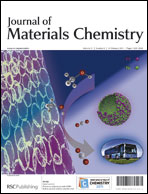Organized mesoporous TiO2 films with high porosity and good connectivity were synthesized via sol–gel by templating an amphiphilic graft copolymer consisting of poly(vinyl chloride) backbone and poly(oxyethylene methacrylate) side chains, i.e., PVC-g-POEM. The randomly microphase-separated graft copolymer was self-reorganized to exhibit a well-ordered micellar morphology upon controlling polymer–solvent interactions, as confirmed by atomic force microscope (AFM) and glazing incidence small-angle X-ray scattering (GISAXS). These organized mesoporous TiO2 films, 550 nm in thickness, were used an an interfacial layer between a nanocrystalline TiO2 thick layer and a conducting glass in dye-sensitized solar cells (DSSC). Introduction of the organized mesoporous TiO2 layer resulted in the increased transmittance of visible light, decreased interfacial resistance and enhanced electron lifetime. As a result, an energy conversion efficiency of DSSC employing polymer electrolyte was significantly improved from 3.5% to 5.0% at 100 mW cm−2.

You have access to this article
 Please wait while we load your content...
Something went wrong. Try again?
Please wait while we load your content...
Something went wrong. Try again?


 Please wait while we load your content...
Please wait while we load your content...